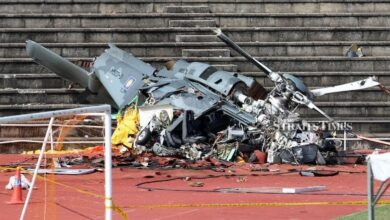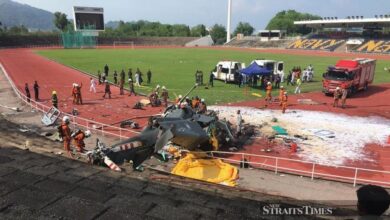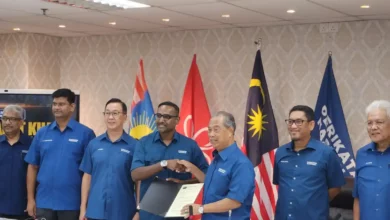Malaya’s finest regiment The Royal Malay Regiment

The Royal Malay Regiment’s past is filled with countless acts of bravery, outstanding leadership and undying loyalty to the nation.
TWO well-preserved Royal Malay Regiment cap badges that surfaced while I was sprucing up a long ignored section of the study brings to mind the Royal Malay Regiment’s long and proud history that began some 90 years ago.
Although the idea of a Malay regiment was mooted in 1913 by the four Federated Malay States rulers, the proposition for a Malay regiment of foot soldiers only gained traction when the winds of war from Europe began blowing towards the Far East.
Compounded by deep concerns over Japan’s rapidly obvious aspirations for a complete Asian conquest, the London War Office, after 20 years of serious “consideration”, finally admitted to the need for more troops to defend Malaya.

NEW MILITARY UNIT FORMED
The two decade-long foot dragging stemmed from uncertainty whether the men, who lacked a modern military tradition, could accept strict British Army discipline and combine it with high efficiency, as well as splendid esprit de corps, to become an effective fighting unit.
All lingering doubts were, however, swept aside on Aug 1, 1933 when a small but impressive unit of 25 men marched onto a roughly gravelled Port Dickson parade ground and snapped into a smart salute before giving a magnificent foot and arms drill display that was as precise and perfectly timed as that of any British infantry regiment. In that momentous day, everyone present watched proudly as the Malay Regiment officially became the latest addition to the long and illustrious list of British Commonwealth fighting units.
Throughout the performance, an immense feeling of pride and mutual loyalty reverberated through the men as their commanding officer, Major George McIllree Stanton Bruce of the Lincolnshire Regiment and adjutant Captain K. G. Exham from the Duke of Wellington’s Regiment looked on with equal satisfaction.
In order to instil pride and loyalty among his men, as well as boost future recruitment efforts, Bruce had gone to great lengths to come up with a handsome regimental mufti that embodied elements of the Malay national dress and befitted the Malay Regiment honour. Together with Exham, he also designed the badge and insignia, which consisted of two tigers supporting a crown that rested atop a circle enclosing a crossed kris and scabbard and bearing the motto “Taat Setia”.
At the same time, three colours were selected. Green represented Islam, yellow represented Malay royalty and red reflected the British army influence.
These striking and meaningful colours were incorporated into the regiment’s walking-out dress which consisted of a green velvet songkok, spotless white top and trousers as well as a green and red silk sarong. Their training outfit, on the other hand, comprised the Gurkha hat, khaki shirt with matching shorts, green putties and black boots.
With well-polished cap badges glistening in the sun, the men looked very smart in their specially designed uniforms.
The sacrifices and untiring efforts made by all concerned after assembling from various towns and villages across Malaya five months earlier had finally come to fruition.

RAPID PROGRESS
Since then, the patience, diligence and keen enthusiasm shared by squad members continued to stand the Malay Regiment in good stead as progress advanced by leaps and bounds. Over the next two years, unit numbers more than quadrupled. By 1936, the first four Malay officers received their swords from Sir Shenton Thomas, the Federated Malay States High Commissioner.
The Malay Regiment was tested for the first time when 6,000 Batu Arang Coal Mine workers went on strike over a labour dispute and passed with flying colours by nipping the March 1937 chaos in the bud. Apart from earning a special commendation from the High Commissioner, the success helped boost morale among the men, giving them the much needed confidence to reach even greater heights.
Inspired, the regiment signed up for training exercises and participated in competitions held throughout Malaya. Among their numerous achievements, the October 1938 Bren-gun course in Singapore proved most momentous when Malay Regiment cadet officers swept all top four places for marksmanship.
Around the same time, the Malay Regiment had grown to 900 strong and this translated to a commendable size of more than a full battalion consisting of three rifle companies and a support company equipped with Vickers machine guns.
The outbreak of war in Europe in 1939 saw mass mobilisations and significant increases in training regimes. Against the backdrop of an imminent Japanese invasion, the Malay Regiment’s 2nd battalion was established to bolster defences. During the Malayan Campaign and subsequent Battle of Singapore in February 1942, the Malay Regiment lost 159 men, including six British officers, seven Malay officers and 146 soldiers of other ranks.
A month later, all Malay Regiment internees were allowed to return home with the exception of seven Malay officers who were executed for refusing to choose between serving the new administration and accepting release by becoming civilians obedient to the Japanese.

TIMELY REVIVAL
My cleaning up process remains at a snail’s pace when sight of several letters sent by servicemen to their loved ones during the late 1940s serves as timely reminder that the Malay Regiment was revived in October 1945 following the end of the Japanese Occupation.
Modernisation efforts swiftly took place in the following two years with the formation of a mechanical engineering service and brigade signals squadron.
In order to groom capable leadership for the future, top performing cadets were sent to the Royal Military Academy in Sandhurst for officer training. By early 1948, the Malay Regiment had full-fledged signallers, wireless and radio mechanics, as well as qualified mechanical engineers trained at the best institutions in the Federation of Malaya and Britain.
This rapid post-war development, however, temporarily came to a halt after Malaya was shaken to its core following the execution-styled murders of three European plantation managers in Elphil Estate by Malayan Communist Party members on June 16, 1948.
Emergency measures were hastily enacted into law following the Sungai Siput incident and the Malay Regiment’s 1st battalion was instructed to guard likely attack points at strategic locations throughout the country.
Although operations against the communist terrorists demanded the greatest qualities of endurance and bravery from the many young Malay officers and soldiers, the men met the challenge splendidly and gallantly took the fight to a ruthless and elusive battle-hardened enemy who knew the land like the back of their hands after taking on the Japanese soldiers for more than three years and had mastered guerrilla warfare.

IMPECCABLE REPUTATION
Despite having to live in the grim, unfriendly jungle for weeks at a time, the recruits took things in their stride. They rose above the challenge by proving to be apt pupils in modern jungle warfare and made amply sure the Malay Regiment’s reputation was as good as any British, Gurkha or Commonwealth force present at that time in the country.
The establishment of the Special Constabulary not long after allowed the Malay Regiment to play a more effective role in mobile operations against the bandits.
A momentous milestone was achieved when a company in Kota Baru was flown to Kedah to take part in operations after which it was promptly sent back to Kelantan in the same manner.
This was the first time in the Malay Regiment’s history that a complete sub-unit was transported by air to take part in a clandestine campaign.
While the early days of the Malayan Emergency greatly favoured the communist terrorists, effective counter-offensives measures taken by the British and Malayan authorities in the months that followed helped to turn the tide.
Among these was the Ferret Force counter-insurgency unit put together by Lieutenant Colonel Walter Walker, a veteran of the World War II Burma Campaign.
Operating in almost impenetrable jungles, Ferret Force teams relied heavily on experienced Dayak and Iban trackers to find secluded communist camps.
Once located, other team members, comprising primarily of Malay Regiment cadets, Chinese volunteers and Commonwealth troop members, moved in swiftly to neutralise the enemy. Other successful tactics included setting up ambushes along suspected infiltration routes to catch guerrilla columns off guard.
Throughout their brief six-month existence, Ferret Force members knew it would take more than their efforts to defeat the insurgents, but took heart that their many successes managed to strike fear in the enemy and kept them off balance.
With each passing tour of duty, Malay Regiment troops garnered invaluable experience in jungle warfare. This allowed them to remain in the jungle for longer periods of time, including month-long aggressive patrols.
During one of those sojourns, units in Pahang received word that the Gua Musang police station had been overrun by 300 bandits who had seized control of the remote Kelantan town.
As men from the 1st Malay Regiment battalion at Kota Baru headed off to retake Gua Musang, two closer sections at Kuala Lipis were immediately dispatched with a sizeable police force to conduct reconnaissance activities and assess enemy positions, as well as strength.
Tracing the old railway track northwards, the men from Pahang ran into a communist ambush. The ensuing gun battle claimed the lives of the company commander Major R. Henderson and four soldiers while three others sustained mortal wounds.
These gallant men represented the first casualty incidence for the Malay Regiment during the Malayan Emergency.
It was also during this unfortunate incident that the heroic actions of Sergeant Osman Itam, who assumed command after Major Henderson fell, earned him the Military Medal, the first of many other Emergency-era awards received by the Malay Regiment. Together with their arriving Kota Baru compatriots and troops from the Royal Gurkha Rifles, the survivors decisively ended the communists’ brief five-day rule in Gua Musang.

LONG AND PROUD HISTORY
Sighs of relief reverberated through a much concerned Malaya after news of the recapture spread like wildfire.
The overwhelming feeling of comfort, no matter how brief, was welcomed with open arms, because had the communists successfully held on to Gua Musang, the victory would have marked the beginning of their strategy to establish a string of liberated areas from where they could extend absolute control over the country. Fortunately for all Malayans, those aspirations did not come to pass.
As the years passed, the Malay Regiment and their other security force compatriots continued to secure victory after victory over the communist terrorists until the twelve-year Malayan Emergency came to an end on July 31, 1960. During that period, their recurring exceptional shows of courage and outstanding leadership earned the courageous warriors many commendations, medals and decorations.
Recognition reached its zenith when they became known as the Royal Malay Regiment on April 9, 1958.
Aside from many notable acts of bravery during the Indonesian Confrontation in the early 1960s, the Royal Malay Regiment also undertook various United Nations sanctioned peacekeeping duties in Congo, Somalia and Bosnia and Herzegovina.
An essential component of Malaysia’s security forces today, the dedicated Royal Malay Regiment servicemen continue in their noble quest to defend our beloved nation against all enemies, foreign and domestic.
nst




